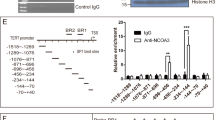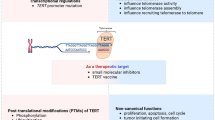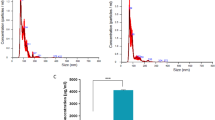Abstract
Telomerase activation through induction of telomerase reverse transcriptase (hTERT) contributes to malignant transformation by stabilizing telomeres. Clinical studies demonstrate that higher hTERT expression is associated with cancer progression and poor outcomes, but the underlying mechanism is unclear. Because epithelial–mesenchymal transition (EMT) and cancer stem cells (CSCs) are key factors in cancer metastasis and relapse, and hTERT has been shown to exhibit multiple biological activities independently of its telomere-lengthening function, we address a potential role of hTERT in EMT and CSCs using gastric cancer (GC) as a model. hTERT overexpression promotes, whereas its inhibition suppresses, EMT and stemness of GC cells, respectively. Transforming growth factor (TGF)-β1 and β-catenin-mediated EMT was abolished by small interfering RNA depletion of hTERT expression. hTERT interacts with β-catenin, enhances its nuclear localization and transcriptional activity, and occupies the β-catenin target vimentin promoter. All these hTERT effects were independent of its telomere-lengthening function or telomerase activity. hTERT and EMT marker expression correlates positively in GC samples. Mouse experiments demonstrate the in vivo stimulation of hTERT on cancer cell colonization. Collectively, hTERT stimulates EMT and induces stemness of cancer cells, thereby promoting cancer metastasis and recurrence. Thus, targeting hTERT may prevent cancer progression by inhibiting EMT and CSCs.
This is a preview of subscription content, access via your institution
Access options
Subscribe to this journal
Receive 50 print issues and online access
$259.00 per year
only $5.18 per issue
Buy this article
- Purchase on SpringerLink
- Instant access to full article PDF
Prices may be subject to local taxes which are calculated during checkout







Similar content being viewed by others
References
Nguyen DX, Bos PD, Massague J . Metastasis: from dissemination to organ-specific colonization. Nat Rev Cancer 2009; 9: 274–284.
Kalluri R, Weinberg RA . The basics of epithelial-mesenchymal transition. J Clin Invest 2009; 119: 1420–1428.
Polyak K, Weinberg RA . Transitions between epithelial and mesenchymal states: acquisition of malignant and stem cell traits. Nat Rev Cancer 2009; 9: 265–273.
Tsuji T, Ibaragi S, Hu GF . Epithelial-mesenchymal transition and cell cooperativity in metastasis. Cancer Res 2009; 69: 7135–7139.
van Zijl F, Zulehner G, Petz M, Schneller D, Kornauth C, Hau M et al. Epithelial-mesenchymal transition in hepatocellular carcinoma. Future Oncol 2009; 5: 1169–1179.
Thiery JP, Acloque H, Huang RY, Nieto MA . Epithelial-mesenchymal transitions in development and disease. Cell 2009; 139: 871–890.
Zeisberg M, Neilson EG . Biomarkers for epithelial-mesenchymal transitions. J Clin Invest 2009; 119: 1429–1437.
Mani SA, Guo W, Liao MJ, Eaton EN, Ayyanan A, Zhou AY et al. The epithelial-mesenchymal transition generates cells with properties of stem cells. Cell 2008; 133: 704–715.
Kurrey NK, Jalgaonkar SP, Joglekar AV, Ghanate AD, Chaskar PD, Doiphode RY et al. Snail and slug mediate radioresistance and chemoresistance by antagonizing p53-mediated apoptosis and acquiring a stem-like phenotype in ovarian cancer cells. Stem Cells 2009; 27: 2059–2068.
Gupta PB, Onder TT, Jiang G, Tao K, Kuperwasser C, Weinberg RA et al. Identification of selective inhibitors of cancer stem cells by high-throughput screening. Cell 2009; 138: 645–659.
Creighton CJ, Li X, Landis M, Dixon JM, Neumeister VM, Sjolund A et al. Residual breast cancers after conventional therapy display mesenchymal as well as tumor-initiating features. Proc Natl Acad Sci USA 2009; 106: 13820–13825.
Waldmann J, Feldmann G, Slater EP, Langer P, Buchholz M, Ramaswamy A et al. Expression of the zinc-finger transcription factor Snail in adrenocortical carcinoma is associated with decreased survival. Br J Cancer 2008; 99: 1900–1907.
Kim MA, Lee HS, Lee HE, Kim JH, Yang HK, Kim WH . Prognostic importance of epithelial-mesenchymal transition-related protein expression in gastric carcinoma. Histopathology 2009; 54: 442–451.
Hayry V, Salmenkivi K, Arola J, Heikkila P, Haglund C, Sariola H . High frequency of SNAIL-expressing cells confirms and predicts metastatic potential of phaeochromocytoma. Endocr Relat Cancer 2009; 16: 1211–1218.
Rosivatz E, Becker I, Specht K, Fricke E, Luber B, Busch R et al. Differential expression of the epithelial-mesenchymal transition regulators snail, SIP1, and twist in gastric cancer. Am J Pathol 2002; 161: 1881–1891.
Liu JP, Chen SM, Cong YS, Nicholls C, Zhou SF, Tao ZZ et al. Regulation of telomerase activity by apparently opposing elements. Ageing Res Rev 2010; 9: 245–256.
Shay JW, Wright WE . Hallmarks of telomeres in ageing research. J Pathol 2007; 211: 114–123.
Hanahan D, Weinberg RA . The hallmarks of cancer. Cell 2000; 100: 57–70.
Shay JW, Bacchetti S . A survey of telomerase activity in human cancer. Eur J Cancer 1997; 33: 787–791.
Chen H, Li Y, Tollefsbol TO . Strategies targeting telomerase inhibition. Mol Biotechnol 2009; 41: 194–199.
Harley CB . Telomerase and cancer therapeutics. Nat Rev Cancer 2008; 8: 167–179.
Boukamp P, Mirancea N . Telomeres rather than telomerase a key target for anti-cancer therapy? Exp Dermatol 2007; 16: 71–79.
Zhou L, Zheng D, Wang M, Cong YS . Telomerase reverse transcriptase activates the expression of vascular endothelial growth factor independent of telomerase activity. Biochem Biophys Res Commun 2009; 386: 739–743.
Cong Y, Shay JW . Actions of human telomerase beyond telomeres. Cell Res 2008; 18: 725–732.
Hamad NM, Banik SS, Counter CM . Mutational analysis defines a minimum level of telomerase activity required for tumourigenic growth of human cells. Oncogene 2002; 21: 7121–7125.
Stewart SA, Hahn WC, O’Connor BF, Banner E, Lundberg A, Modha P et al. Telomerase contributes to tumorigenesis by a telomere length-independent mechanism. Proc Natl Acad Sci USA 2002; 99: 12606–12611.
Dudognon C, Pendino F, Hillion J, Saumet A, Lanotte M, Segal-Bendirdjian E . Death receptor signaling regulatory function for telomerase: hTERT abolishes TRAIL-induced apoptosis, independently of telomere maintenance. Oncogene 2004; 23: 7469–7474.
Luiten RM, Pene J, Yssel H, Spits H . Ectopic hTERT expression extends the life span of human CD4+ helper and regulatory T-cell clones and confers resistance to oxidative stress-induced apoptosis. Blood 2003; 101: 4512–4519.
Zhang X, Mar V, Zhou W, Harrington L, Robinson MO . Telomere shortening and apoptosis in telomerase-inhibited human tumor cells. Genes Dev 1999; 13: 2388–2399.
Cao Y, Li H, Deb S, Liu JP . TERT regulates cell survival independent of telomerase enzymatic activity. Oncogene 2002; 21: 3130–3138.
Domont J, Pawlik TM, Boige V, Rose M, Weber JC, Hoff PM et al. Catalytic subunit of human telomerase reverse transcriptase is an independent predictor of survival in patients undergoing curative resection of hepatic colorectal metastases: a multicenter analysis. J Clin Oncol 2005; 23: 3086–3093.
Gertler R, Rosenberg R, Stricker D, Friederichs J, Hoos A, Werner M et al. Telomere length and human telomerase reverse transcriptase expression as markers for progression and prognosis of colorectal carcinoma. J Clin Oncol 2004; 22: 1807–1814.
Terrin L, Rampazzo E, Pucciarelli S, Agostini M, Bertorelle R, Esposito G et al. Relationship between tumor and plasma levels of hTERT mRNA in patients with colorectal cancer: implications for monitoring of neoplastic disease. Clin Cancer Res 2008; 14: 7444–7451.
Tabori U, Ma J, Carter M, Zielenska M, Rutka J, Bouffet E et al. Human telomere reverse transcriptase expression predicts progression and survival in pediatric intracranial ependymoma. J Clin Oncol 2006; 24: 1522–1528.
Ohali A, Avigad S, Cohen IJ, Meller I, Kollender Y, Issakov J et al. Association between telomerase activity and outcome in patients with nonmetastatic Ewing family of tumors. J Clin Oncol 2003; 21: 3836–3843.
Takaishi S, Okumura T, Tu S, Wang SS, Shibata W, Vigneshwaran R et al. Identification of gastric cancer stem cells using the cell surface marker CD44. Stem Cells 2009; 27: 1006–1020.
Levings PP, McGarry SV, Currie TP, Nickerson DM, McClellan S, Ghivizzani SC et al. Expression of an exogenous human Oct-4 promoter identifies tumor-initiating cells in osteosarcoma. Cancer Res 2009; 69: 5648–5655.
Gerrard L, Zhao D, Clark AJ, Cui W . Stably transfected human embryonic stem cell clones express OCT4-specific green fluorescent protein and maintain self-renewal and pluripotency. Stem Cells 2005; 23: 124–133.
Vincent T, Neve EP, Johnson JR, Kukalev A, Rojo F, Albanell J et al. A SNAIL1-SMAD3/4 transcriptional repressor complex promotes TGF-beta mediated epithelial-mesenchymal transition. Nat Cell Biol 2009; 11: 943–950.
Chaudhury A, Hussey GS, Ray PS, Jin G, Fox PL, Howe PH . TGF-beta-mediated phosphorylation of hnRNP E1 induces EMT via transcript-selective translational induction of Dab2 and ILEI. Nat Cell Biol 2010; 12: 286–293.
Zhou BP, Deng J, Xia W, Xu J, Li YM, Gunduz M et al. Dual regulation of Snail by GSK-3beta-mediated phosphorylation in control of epithelial-mesenchymal transition. Nat Cell Biol 2004; 6: 931–940.
Medici D, Hay ED, Olsen BR . Snail and Slug promote epithelial-mesenchymal transition through beta-catenin-T-cell factor-4-dependent expression of transforming growth factor-beta3. Mol Biol Cell 2008; 19: 4875–4887.
Park JI, Venteicher AS, Hong JY, Choi J, Jun S, Shkreli M et al. Telomerase modulates Wnt signalling by association with target gene chromatin. Nature 2009; 460: 66–72.
Counter CM, Hahn WC, Wei W, Caddle SD, Beijersbergen RL, Lansdorp PM et al. Dissociation among in vitro telomerase activity, telomere maintenance, and cellular immortalization. Proc Natl Acad Sci USA 1998; 95: 14723–14728.
Fuchs BC, Fujii T, Dorfman JD, Goodwin JM, Zhu AX, Lanuti M et al. Epithelial-to-mesenchymal transition and integrin-linked kinase mediate sensitivity to epidermal growth factor receptor inhibition in human hepatoma cells. Cancer Res 2008; 68: 2391–2399.
Kudo-Saito C, Shirako H, Takeuchi T, Kawakami Y . Cancer metastasis is accelerated through immunosuppression during Snail-induced EMT of cancer cells. Cancer Cell 2009; 15: 195–206.
Visvader JE, Lindeman GJ . Cancer stem cells in solid tumours: accumulating evidence and unresolved questions. Nat Rev Cancer 2008; 8: 755–768.
Liu H, Patel MR, Prescher JA, Patsialou A, Qian D, Lin J et al. Cancer stem cells from human breast tumors are involved in spontaneous metastases in orthotopic mouse models. Proc Natl Acad Sci USA 2010; 107: 18115–18120.
Sarin KY, Cheung P, Gilison D, Lee E, Tennen RI, Wang E et al. Conditional telomerase induction causes proliferation of hair follicle stem cells. Nature 2005; 436: 1048–1052.
Dissanayake SK, Wade M, Johnson CE, O’Connell MP, Leotlela PD, French AD et al. The Wnt5A/protein kinase C pathway mediates motility in melanoma cells via the inhibition of metastasis suppressors and initiation of an epithelial to mesenchymal transition. J Biol Chem 2007; 282: 17259–17271.
Yook JI, Li XY, Ota I, Hu C, Kim HS, Cha SY et al. A Wnt-Axin2-GSK3beta cascade regulates Snail1 activity in breast cancer cells. Nat Cell Biol 2006; 8: 1398–1406.
Stemmer V, de Craene B, Berx G, Behrens J . Snail promotes Wnt target gene expression and interacts with beta-catenin. Oncogene 2008; 27: 5075–5080.
Strong MA, Vidal-Cardenas SL, Karim B, Yu H, Guo N, Greider CW . Phenotypes in mTERT/ and mTERT/ mice are due to short telomeres, not telomere-independent functions of telomerase reverse transcriptase. Mol Cell Biol 2011; 31: 2369–2379.
Marian CO, Cho SK, McEllin BM, Maher EA, Hatanpaa KJ, Madden CJ et al. The telomerase antagonist, imetelstat, efficiently targets glioblastoma tumor-initiating cells leading to decreased proliferation and tumor growth. Clin Cancer Res 2010; 16: 154–163.
Liu L, Liu C, Lou F, Zhang G, Wang X, Fan Y et al. Activation of telomerase by seminal plasma in malignant and normal cervical epithelial cells. J Pathol 2011; 225: 203–211.
Acknowledgements
We thank Drs RA Weinberg (Massachusetts Institute of Technology), CM Counter (Duke University), JM Wong and K Collins (University of California, Berkeley), Y Cong (Beijing Normal University) and W Cui (Imperial College London) for retroviral vectors and plasmids.This study was supported by the National Basic Research Program of China (grant No. 973 Program 2012CB911202), the Swedish Cancer Society, the Swedish Research Council, Cancer Society in Stockholm, Swedish Child Cancer Society, the Karolinska Institutet Foundations, National Natural Science Foundation of China (No.: 30770118, 30800406, 30972775, 81071721, 81000868, 81171536), the National Key Scientific Program of China (2007CB914801) and the Science Foundation of Shandong Province (No.: ZR2009CZ001, ZR2009CM002 and BS2010YY040)
Author information
Authors and Affiliations
Corresponding authors
Ethics declarations
Competing interests
The authors declare no conflict of interest.
Additional information
Supplementary Information accompanies the paper on the Oncogene website
Supplementary information
Rights and permissions
About this article
Cite this article
Liu, Z., Li, Q., Li, K. et al. Telomerase reverse transcriptase promotes epithelial–mesenchymal transition and stem cell-like traits in cancer cells. Oncogene 32, 4203–4213 (2013). https://doi.org/10.1038/onc.2012.441
Received:
Accepted:
Published:
Issue Date:
DOI: https://doi.org/10.1038/onc.2012.441
Keywords
This article is cited by
-
Efficacy of GV1001 with gemcitabine/capecitabine in previously untreated patients with advanced pancreatic ductal adenocarcinoma having high serum eotaxin levels (KG4/2015): an open-label, randomised, Phase 3 trial
British Journal of Cancer (2024)
-
Dyskerin and telomerase RNA component are sex-differentially associated with outcomes and Sunitinib response in patients with clear cell renal cell carcinoma
Biology of Sex Differences (2023)
-
Loss of CDH16 expression is a strong independent predictor for lymph node metastasis in Middle Eastern papillary thyroid cancer
Scientific Reports (2023)
-
Identification and validation of telomerase related lncRNAs signature to predict prognosis and tumor immunotherapy response in bladder cancer
Scientific Reports (2023)
-
The dynamics of telomere length in primary and metastatic colorectal cancer lesions
Scientific Reports (2023)



